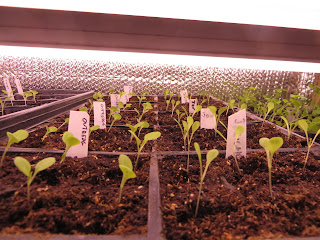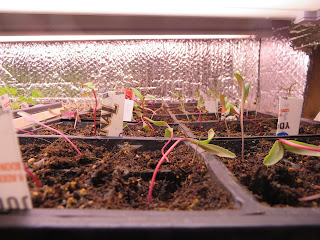Hey Folks:
 Thanks to those of you who are visiting this site for the first time. We hope you enjoy our farm website as much as the real thing.
Thanks to those of you who are visiting this site for the first time. We hope you enjoy our farm website as much as the real thing. Unfortunately, the electronic farm experience is not quite as tasty. I hope it will whet your appetite for fresh, certified organic produce.
If you have any questions about the farm, feel free to contact me at the email address or phone number below.
Your advance payment will ensure a share of this year’s harvest. Harvest deliveries start in June and run through to the end of October. There are a couple of deliveries anticipated for November (cold hardy leaves and storage produce such as carrots and kidney beans).
Why I use Flyers to find customers:
To keep our doorstep delivery cost efficient, I restrict my customer base to particular neighborhoods. This renders print and electronic advertising somewhat ineffective.
I use very simple flyers (printed at home on standard print paper) to keep costs down. I realize most flyers will wind up being recycled, so I do not create extra expense with glossy, professionally cut flyers.
I do not leave flyers if I see a “no flyers please” sign on your mailbox. If I did not notice your request to this effect, please accept my apologies.
Still room for more customers...feel free to call the number at the bottom f the page, I am in most evenings.
Bob Whitmore

These are the first peppers to sprout.
In another week or so, they will be transferred to the outdoor nursery to start their cold treatment.
I am growing three types of sweet peppers this season:
Lipstick, an open pollinated sweet pepper that is cone shaped.
Olympus, a standard green pepper that did well for us last season.
And I am finishing off some seed from a bell pepper I used to grow called Yarden. It takes about a week or two longer to develop fruit than the Lipstick,or Olympus, so I will be discontinuing it after our seed runs out.
Onions as far as the eye can see. Looks like they are ready for their next haircut.
In another week or two, they will be gradually introduced to the outdoor nursery to prepare them for an early planting.
The sooner I can get the onions outside, the more opportunity they will have to grow without being bothered by the leek moths, which do not come out until nights are above ten degrees.
Onions are somewhat tolerant to cool weather. Some straw and row cover will keep them sheltered during the cool nights in May.
The parsley I grow is a flat leaf type. Less cold tolerant than curly parsley but much easier to clean.
There is some debate I have heard about which type has the better flavor, but I (and others) have suggested that growing methods can have as much impact on the culinary performance as type does.
For myself, parsley is one of two crops I have to harvest after I have eaten my lunch. This ensures everyone else gets their fair share.
For ideas on how to use this 'garnish' as a centrepiece flavour in your food, check out the 'Introducing Our 2016 Crops' page.

The first lettuces have been promoted, the second round is sown.
I have chosen four varieties of romaine to start the seasons lettuce. My goal is to provide three to four mini romaines for the first two deliveries.
In early spring, leaves grow slowly due to the combination of cool temperature and short days.
I chose romaine lettuce as it can be planted in a much closer spacing than head lettuce varieties, allowing more plants per bed.
A full head of lettuce typically takes 48 to 58 days to reach harvest maturity. To deliver this on June first would require planting the crop out in the second week of April - a bit too early for our climate.
The romaines I have chosen are suitable for mini lettuce production, meaning that there will be a decent amount of leaves in each plant 28 days after transplant.
The tomatoes, eggplant, and peppers continue to grow.
First disaster of the year occurred while watering the other day. A tray of cherry tomato sprouts didn't quite balance on the shelf (always a lack of space at this time of year!) and took a tumble.
Most of the plants were salvaged, but a few were broken and a couple are not looking too healthy today. I may have to start a few more plants to make up for these. Fortunately, this variety has the shortest maturity date, so a few late plants will not make much difference.
It could have been worse....

Chard always seems to look so helpless after promoting - the stems are not rigid and so the plants flop over.
I transplant the chard at about 10"spacing for full sized plants. It takes about 60 days to get the plants large enough to offer up a serving for everyone.
This year, i want an an early harvest, so I am doubling the amount of chard for transplant and transplant them at 5". For the first harvest, I will harvest half of the plants which should give me enough to deliver to everyone.
As the 'rhubarb red' variety is most suitable for mini chard, I am concentrating on growing more of these than the white stemmed 'silverado' variety.
Still room for a few customers, let me know soon...time is almost running out for early season requests.



